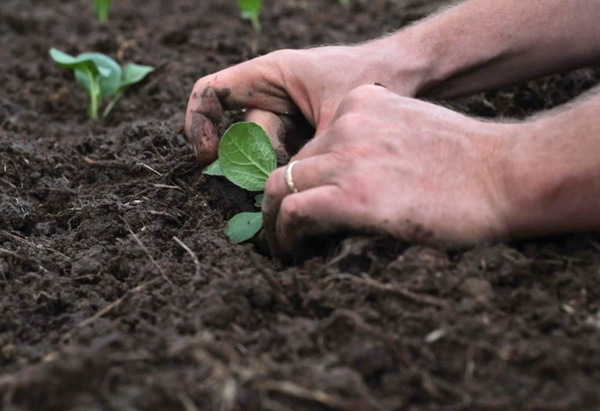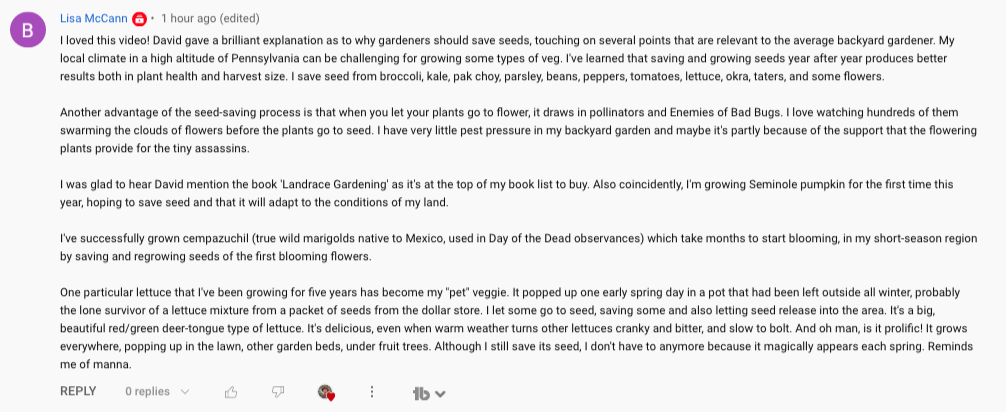Lisa writes:
I loved this video! David gave a brilliant explanation as to why gardeners should save seeds, touching on several points that are relevant to the average backyard gardener.
My local climate in a high altitude of Pennsylvania can be challenging for growing some types of veg. I’ve learned that saving and growing seeds year after year produces better results both in plant health and harvest size. I save seed from broccoli, kale, pak choy, parsley, beans, peppers, tomatoes, lettuce, okra, taters, and some flowers.
Another advantage of the seed-saving process is that when you let your plants go to flower, it draws in pollinators and Enemies of Bad Bugs. I love watching hundreds of them swarming the clouds of flowers before the plants go to seed. I have very little pest pressure in my backyard garden and maybe it’s partly because of the support that the flowering plants provide for the tiny assassins.
I was glad to hear David mention the book ‘Landrace Gardening’ as it’s at the top of my book list to buy.
Also coincidently, I’m growing Seminole pumpkin for the first time this year, hoping to save seed and that it will adapt to the conditions of my land. I’ve successfully grown cempazuchil (true wild marigolds native to Mexico, used in Day of the Dead observances) which take months to start blooming, in my short-season region by saving and regrowing seeds of the first blooming flowers. One particular lettuce that I’ve been growing for five years has become my “pet” veggie. It popped up one early spring day in a pot that had been left outside all winter, probably the lone survivor of a lettuce mixture from a packet of seeds from the dollar store. I let some go to seed, saving some and also letting seed release into the area. It’s a big, beautiful red/green deer-tongue type of lettuce. It’s delicious, even when warm weather turns other lettuces cranky and bitter, and slow to bolt. And oh man, is it prolific! It grows everywhere, popping up in the lawn, other garden beds, under fruit trees. Although I still save its seed, I don’t have to anymore because it magically appears each spring. Reminds me of manna.
Lisa left that comment on this video:
She’s having success adapting seeds to her climate, using the same techniques we use here and Joseph Lofthouse uses in Utah.
Though I can’t always share gardening information specific to each climate in which my various viewers are located, we do use a lot of principles and techniques that apply universally. The Grocery Row Garden system is universal, as is Landrace Gardening. Composting, single row gardening, etc., are also universal.
Work with the climate God gave you, adapt your plantings to it, and use what you can of the advice you get on YouTube and in books. We’ve learned from gardeners in the tropics and gardeners in the far north, gardeners in arid climates and gardeners in the rain forest. Eat the meat, spit out the bones.
Then throw the bones in the compost pile.



2 comments
I like that comment. I’ve also been saving seeds for some things. I also have blooming flowers interspersed with veggies and seem to have an abundance of native bees around. Along the lines of bringing in “enemies of bad bugs” I saw a big old wasp pluck a little army worm off one of my tomato plants and almost flew in my face carrying it away. I felt like I witnessed a miracle. It was so exciting.
Isn’t it great? I used to be so scared of wasps. Feels like I’ve come such a long way– today, I watched a wasp cruising around my garden, checking out each plant. I was confused for a minute– like, what is it looking for? It wasn’t landing on anything. They don’t eat leaves. And then it dawned on me: it’s looking for BUGS to bugnap and carry off to the nest to feed its babies. I’ve broken open wasp nests before, and seen the bugs in there, waiting for the eggs to hatch and the larvae to eat them, like little wasp MREs.
If you plant those long red-speckled beans, or passionflower vine, they’ll actually attract wasps to the garden– they have these little nodes on the stems that the wasps and ants go nuts over. I think the plants must be sending out some kind of wasp-specific come-hither pheromones, and pest control is what the plant gets out of it. Made the mistake one year of planting those beans so that they climbed up the porch railing, which seemed like a really convenient trellis. Had to run the wasp gauntlet at the front door all summer long. Only got stung once, but still… not right by the house door, next time.
Comments are closed.